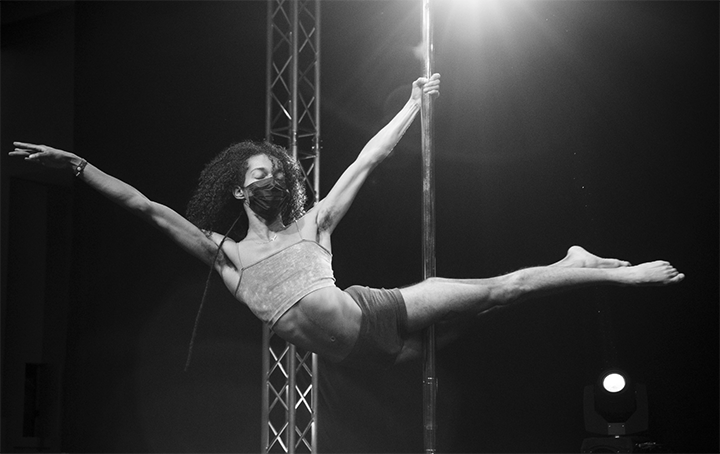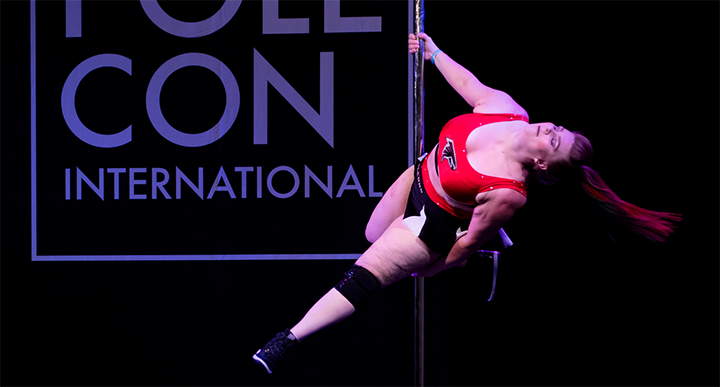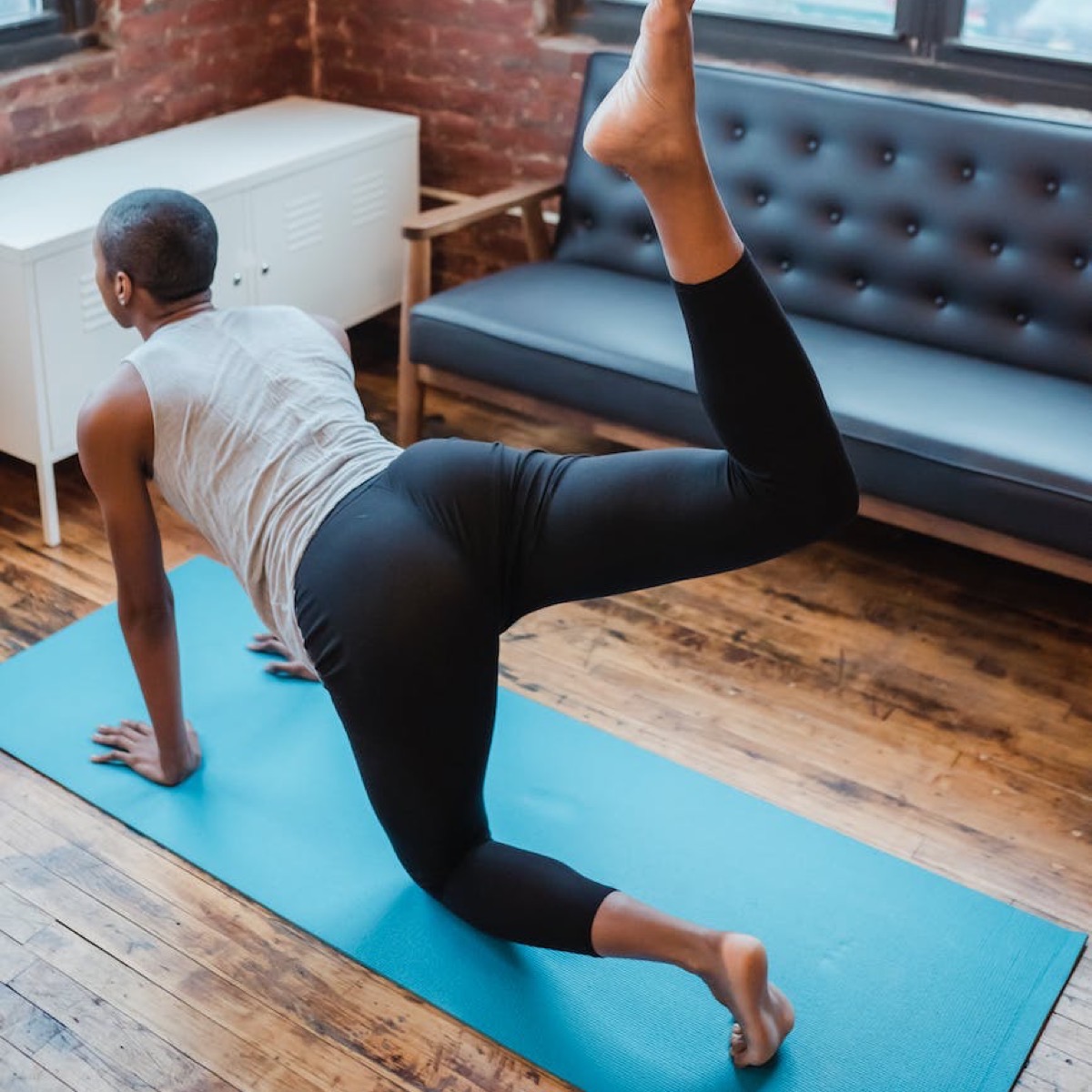I recently saw a reel on Instagram with this tall, thin, gorgeous 20 something young…

5 THINGS YOGIS DO BETTER THAN POLE DANCERS
And how we can learn from them to improve our pole lives.
 I was never someone who practiced yoga regularly—just jumped into a random class here or there every few months. Compared to all the gymnastics and pole and aerial and contortion in my life, I’ve always had a “How hard can this be?” attitude towards yoga. It seemed like a kind of fun, gentle workout that people-who-are-greater-hippies-than-I did. It wasn’t really my cup of tea; I’d rather be throwing myself around in the air and feeling like a superhero. Whenever I took a yoga class I’d wish we could hold off on the OMMMMs and the talking about energy and feelings and just get into the Real Work.
I was never someone who practiced yoga regularly—just jumped into a random class here or there every few months. Compared to all the gymnastics and pole and aerial and contortion in my life, I’ve always had a “How hard can this be?” attitude towards yoga. It seemed like a kind of fun, gentle workout that people-who-are-greater-hippies-than-I did. It wasn’t really my cup of tea; I’d rather be throwing myself around in the air and feeling like a superhero. Whenever I took a yoga class I’d wish we could hold off on the OMMMMs and the talking about energy and feelings and just get into the Real Work.
But I respected that yoga was doing something right, because it got so many people who didn’t do other forms of fitness to move and stretch. And I respected the rate at which it’s grown within the fitness industry, like a freaking weed. Yoga classes are EVERYWHERE and are retaining students in a way that pole dance classes are decidedly not. So I decided to get certified as a yoga teacher.
I didn’t put a whole lot more thought into it than that —I went into my yoga training just to get another fitness certification under my belt (albeit a very expensive one!) The crazy thing was, though, that I came out of the training with so much more. I came out with a completely different perspective of what my role is as a teacher, and what I can offer to my students. Straight from the inside, here are the top 5 things that Yogis are doing better than us Polers:
1. Training the mind just as hard as the body.
There are a lot of words and phrases that get tossed around pole studios and pole events, but they don’t always sink in.
“Don’t compare yourself to others.”
“Don’t rush – you’ll get that trick when you’re ready.”
“Don’t be hard on yourself if something isn’t working today.”
Ok, let’s be real. I can say these things to students over and over. But the fact of the matter is, as humans in the modern world, almost all of us compare ourselves to others. We’ve been taught to compare ourselves to others, to always be working towards a finish line, and to feel bad about ourselves if we’re not the first to cross it. So as a teacher, I can say, “Don’t compare yourself,” but me saying that a few times in an hour-long class is probably not going to counteract all of the rest of the years of your life in which other voices have told you the opposite.
The thing that Yoga does better is that it tells you something you SHOULD do with your thoughts, rather than just what you should not. It brings in guidelines and instruction for how to calm and focus your mind. A student who is training their mind equally as hard as their body is the student that will be unstoppable. Granted – students are probably not coming to pole class for a discussion of philosophy and meditation. But here’s the secret: most beginner yoga students in the Western world aren’t looking for that either. Yoga gives it to them *anyway*, and it ends up completely changing the way people work both mentally and physically.
2. Considering mental achievements to be as great as physical achievements.
Similar to what’s above, but not exactly the same. Let’s rewind and think: how many pole classes or practices have you walked away from and felt like you didn’t do the best you’ve ever done? Your handspring wasn’t the strongest, or your back wasn’t the bendiest. When that happens, we tend to only focus on the poor physical practice and the physical results. We don’t see progress, and then we feel like crap.
But what about the mental side of your practice? What did the rest of your day look like? Did you have a crazy day at work? Did you get bad news? And what about the actual thing you were practicing—were you running a complex string of tricks for the first time? Was there mental work required to coordinate that? Were you in a new studio setting, with a completely new set of people and social cues to navigate?
My point is, any time you are doing a physical practice on the pole, there is a mental practice happening too, but we don’t give ourselves credit for it. Yogis do. A yoga practice encourages self-reflection and uniting the mind and the body. Maybe you did a crappy handstand today, but you got yourself to practice even though you had a really, really hard day. Mentally, that’s a huge achievement, and one that should be rewarded equally (if not more) than the actual state of your handstand.
3. Respecting the limitations of the body.
So here’s the thing. We pole dancers want to be able to do it all. We saw 200 crazy new tricks on Instagram in the past 2 hours and feel like we’re falling behind. We then try to power and twist our way into them, without thinking about a lot of things. Like, what were the body proportions of the people doing those crazy tricks? Did they have really long arms, so that twisting around the pole and grabbing other limbs was easier for them? Did they have short legs, so holding up the lower half of their body against gravity was easier for them? Have they been training their splits for more years than you have been alive, so the splits were easier for them?
The fitness industry loves throwing around phrases like “NO LIMITS!!!!!” Which can be inspiring, to a point. But sometimes there are physical limits. If you have very small hands, it is a hell of a lot harder for you to grip the pole with just your hands. This is a reality that it’s ridiculous to ignore. Maybe one-handed body spirals are not going to be your best trick, and you shouldn’t beat yourself up for it. We need to respect the differences in our bodies, use it to our advantage, and let the rest go. This is rarely how a pole class or workshop is taught. (…though if you ask any professional pole dancer, they absolutely have a list of tricks that they won’t do with their own body. Food for thought.)
This is something Yogis do 100% better than us. They listen to their bodies. And because it isn’t all about the physical achievements, it doesn’t mean they’re less of a yogi if they aren’t holding a handstand for 5 minutes. Just sitting still for 5 minutes is an enormous mental accomplishment, and one that anyone can practice regardless of if you’re built like an Olympic gymnast or not. And you’ll walk away from that meditation feeling calm, in-control, and if you get really good at it, maybe even completely ecstatic. Kind of like you would have felt if you just Fonji’d. Because the euphoria that you feel when you nail a cool new trick is just chemicals being triggered in your brain, right? Are you still with me, or have I gone too far off the deep end?
4. Building supportive and loving connections between all people.
So once you’ve gotten your own head under control and you’re transcendentally meditating and you could be perfectly content doing nothing harder than dip turns and pirouettes… Let’s talk about your relations with everyone around you. How do you feel when you have to share a pole? How do you feel if that person is more advanced than you, or less advanced? How do you act?
Pole is usually learned in groups, and after having visited and taught at many different studios, I can confidently say some studios succeed at creating a supportive environment for all students, and some do not. And to put the hippy-dippy stuff aside for a second, if a studio does not feel supportive to a student, then that student is probably not going to keep paying to come back.
Studio culture, much like any culture, is not something that just “happens”. A lot of it happens organically, but it’s also always shaped by leaders. And much like yoga straight-up discusses how to train your mind, it also puts time into discussing how you should interact with other people in the room and in the world. That OMMMMM thing actually does a really good job of making you feel how you are all in it together, united, and sharing a common experience.
And then Boom: educating people on how to connect with each other and making that part of the learning experience does change the way people interact. Yogis have made building a supportive culture a central tenet of their practice. This benefits everyone in the community, creating a happy, safe place where all different kinds of people can practice, and therefore tons of people flock to it and the entire industry grows.
5. Fitting a ton of people in a room.
 And you know what else yoga does right? All you need is a mat! You can fit so many mats in a small space and everyone still gets a great class experience! You can be literally anywhere and still practice yoga! No complicated equipment mounted between floors and ceilings needed.
And you know what else yoga does right? All you need is a mat! You can fit so many mats in a small space and everyone still gets a great class experience! You can be literally anywhere and still practice yoga! No complicated equipment mounted between floors and ceilings needed.
Yogis are doing this so much better. Though I don’t really know what the lesson to be learned here is… Other than we should all do more yoga, so that when we end up somewhere without a pole setup we don’t go completely crazy and still have something fulfilling to work on in the meantime.
Don’t get me wrong: Pole will always have my heart. Pole dancers are way better at covering things in rhinestones and glitter. Way better at hair whips, heel clacks, Sunday Bumday ass selfies, and unleashing the fierce sexy beast inside absolutely anyone. But we can still always do better, and start integrating these important lessons from the Yogis. Pole could be a happier, healthier place with less injuries and more student retention. Learning more about yoga has changed the way I teach in many ways, and I’m excited to keep going deeper and learning more. I look forward to building an army of hybrid pole-yogi superheroes that can laser-focus their minds just as well as they can spreadie.
Latest posts by Liz Kinnmark (see all)
- We’re Here, We’re Queer, & We’re Never Gonna Leave! - May 24, 2019
- TOP 10 WORKSHOPS FOR THE BEGINNER POLE DANCER - May 13, 2017
- 5 THINGS YOGIS DO BETTER THAN POLE DANCERS - September 23, 2016
This Post Has One Comment
Comments are closed.



[…] I recently found this gem over on the Pole Convention blog, about how we as pole dancers can learn from the practises in yoga. […]